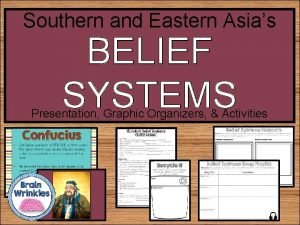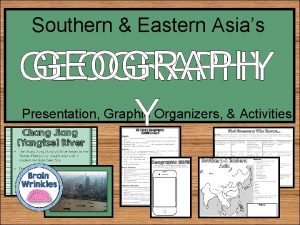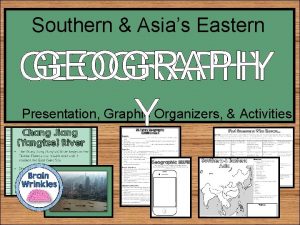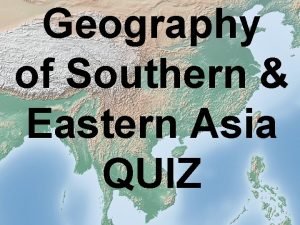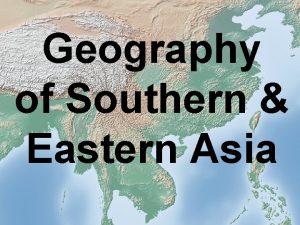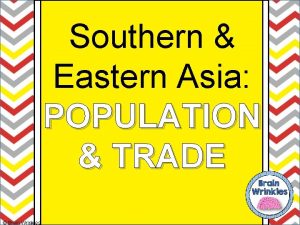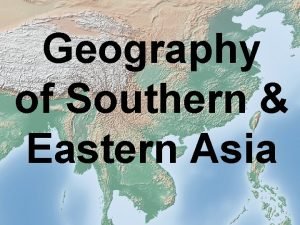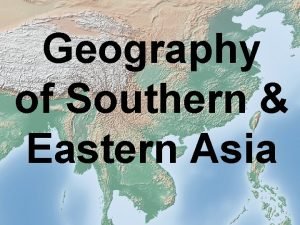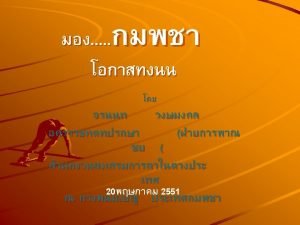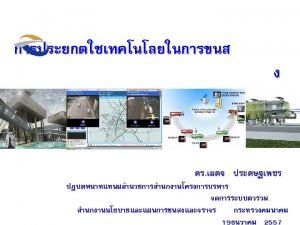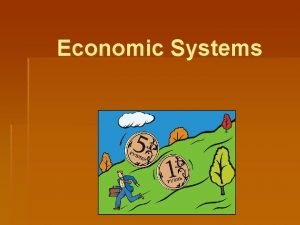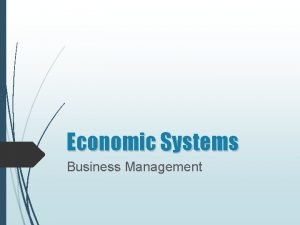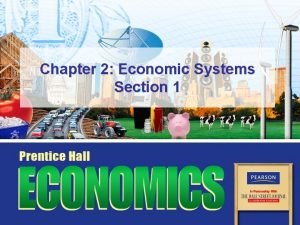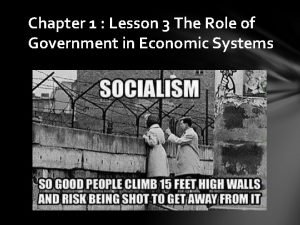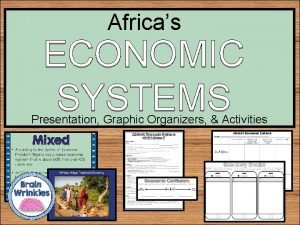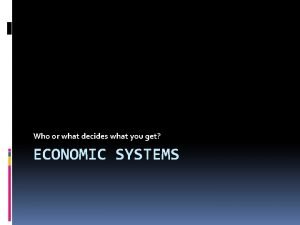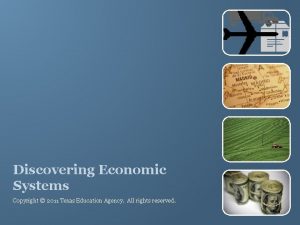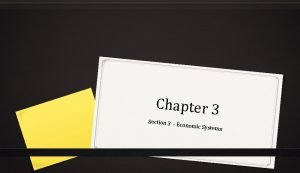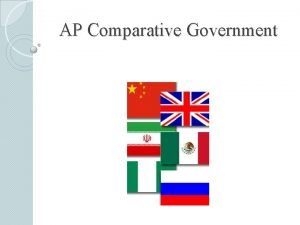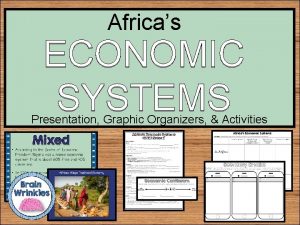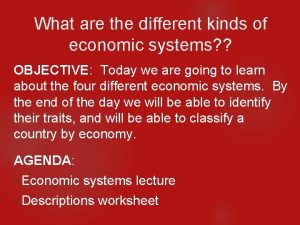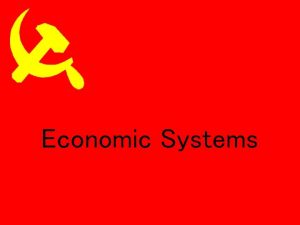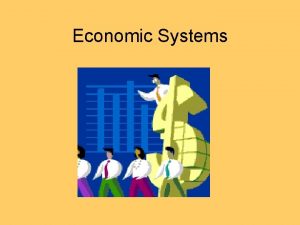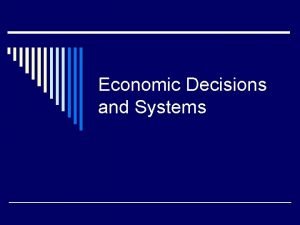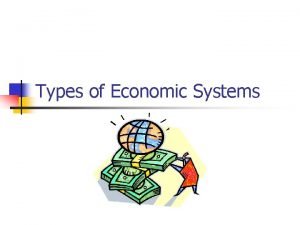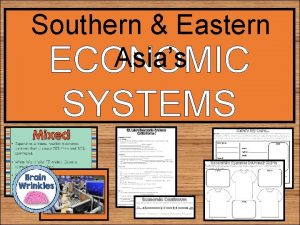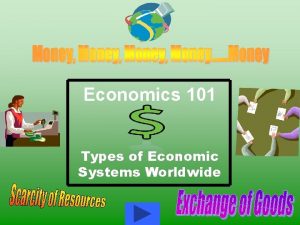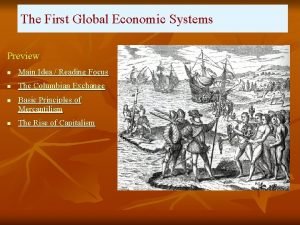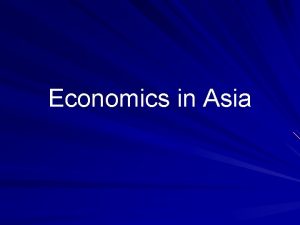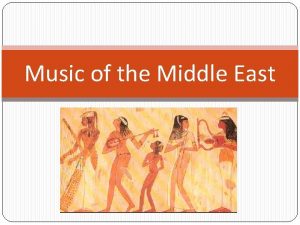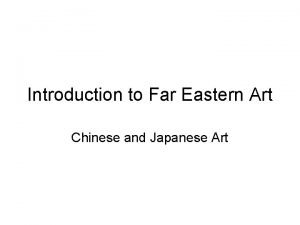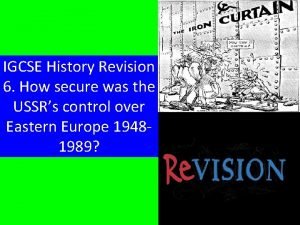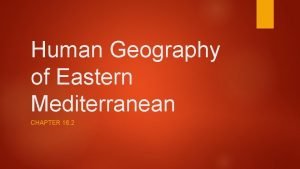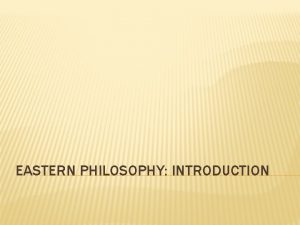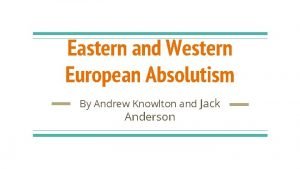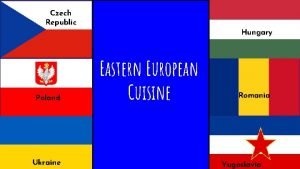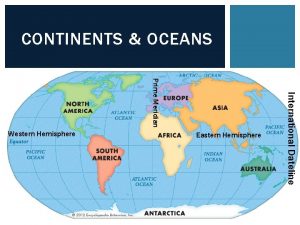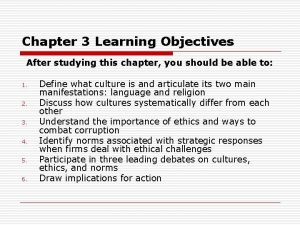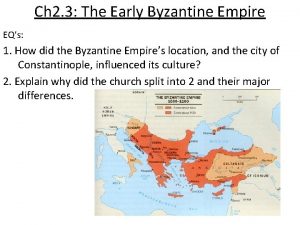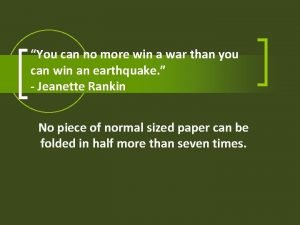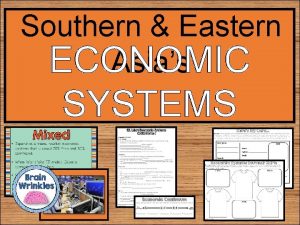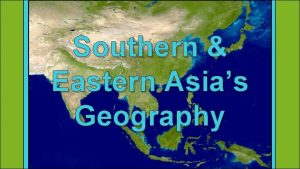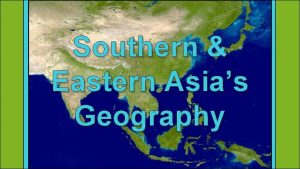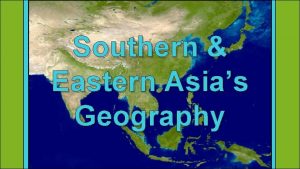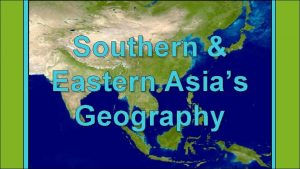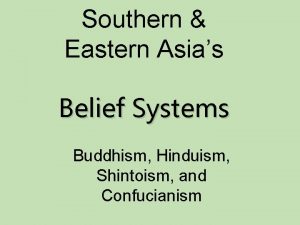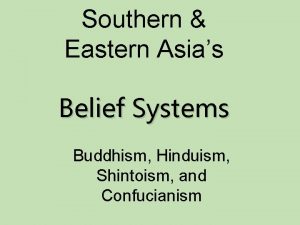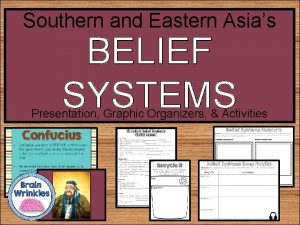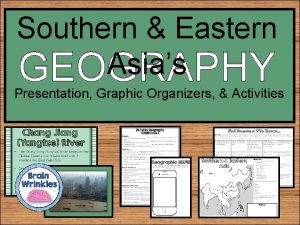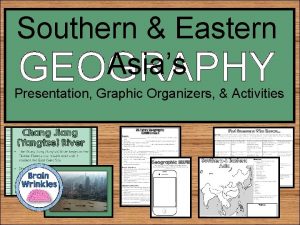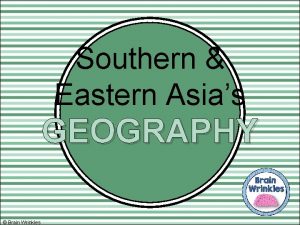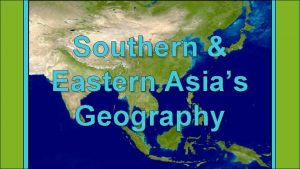Southern Eastern Asias ECONOMIC SYSTEMS STANDARDS SS 7












































































- Slides: 76

Southern & Eastern Asia’s ECONOMIC SYSTEMS

STANDARDS: SS 7 E 7 Analyze different economic systems. a. Compare how traditional, command, and market economies answer the economic questions of 1 what to produce, 2 -how to produce, and 3 -for whom to produce. b. Explain that countries have a mixed economic system located on a continuum between pure market and pure command. c. Compare and contrast the economic systems in China, India, Japan, North Korea, and South Korea. © Brain Wrinkles

TEACHER INFO: CLOZE Notes • The next pages are handouts for the students to use for note-taking during the presentation. (Print front to back to save paper and ink. ) • Check the answers as a class after the presentation. © Brain Wrinkles

SE Asia’s Economic Systems CLOZE Notes 1 ECONOMIC SYSTEMS Let’s Review • Do you remember the three questions that every country must answer when developing its economic plan? • ______________ will be produced? • ___________________________ the goods/services? • The way a country answers these questions determines its ______________ (Traditional, Command, or Market). Traditional • This system answers the three economic questions based on traditional ______________ of the past. • The values and traditions have been ______________ to generation. • Some ______________ have traditional economies where the people still follow the way of life of their ancestors. Command • This system answers the three economic questions through ______________. • The ______________ of the country’s economic decisions: prices of goods, wages of workers, goods to be made, etc. • China’s ______________ was an example of a command system. • This system is ______________ ; because of this, there are no PURE command countries in the world today. • Some ______________ : Cuba, former Soviet Union, North Korea, former East Germany, etc. • All of these countries have the same type of government: ______________ ! • The government is ______________ of everything. Market • This system answers the three economic questions based on ______________ in the market place. • The goods and services produced are determined by what the people ______________. • The government ______________ over the economy; private citizens answer all economic questions. © Brain Wrinkles

SE Asia’s Economic Systems CLOZE Notes 2 Market • In a truly free market economy, the government would ______________ at all. Scary… • There would be no laws to make sure goods/services ______________. *Food! Medicine! • There would be no ______________ workers from unfair bosses. • Because of this, there are no PURE market economies, but some countries are ______________. Mixed • Since there are ______________ with either a “pure command” or a “pure market” economy, what does that make them? • Most democratic countries have some ______________ systems, so we keep it simple and call them: ______________. • Their economies are not run entirely by government commands, nor do they side with the free market 100% of the time—they are ______________. • Of course, most countries’ economies are ______________ of system than another. SE Asia • Most countries in Southern and Eastern Asia have ______________ ; however many of them have a high level of government involvement that leans ______________ than to market. • Strictly-controlled prices and ______________ are common throughout the region, especially in China and North Korea. • On the other hand, the region also has some countries with ______________ , like South Korea and Japan. CHINA Mixed • China has a ______________ that is about 57% free and 43% command. • China is transitioning from a command economy controlled by the ______________ government, towards a mixed market one with more economic freedom for individuals. • Since China started loosening up the centrally planned economy in the 1970 s, ______________ have produced much more of China’s growth. Growth • China’s economy is the ______________ in the world, as well as the largest economy in the world. • Economists predict that within the next twenty years, China will ______________ in economic strength. © Brain Wrinkles

SE Asia’s Economic Systems CLOZE Notes 3 Freedom • Throughout the past several decades, China has transitioned away from a centrallyplanned command economy and is moving more ______________ one. • China’s national government has let more and more citizens and private corporations ______________ that it previously owned. • The government has also allowed farmers to make their own decisions regarding crops, rather than ______________. • The government has loosened its control and now ______________ among businesses, which has helped the economy grow. • Today, Chinese companies have more ______________ of their goods based on supply and demand of the market. • China’s government has also allowed businesses to ______________ through investments made in a stock market. Regulation • While private enterprise is playing a larger role in China’s economy, the national government is still ______________ in the country’s economic planning. • The biggest companies in China are ______________. • The government operates industries like banking, oil, airlines, and ______________. • It also ______________ in order to pay for infrastructure and social services. INDIA Mixed • India has a ______________ that is about 53% free and 47% command. • When India gained independence in 1947, its government set up a ______________ and controlled all industries and production. • Since the early 1990 s, the government ______________ and has allowed private businesses to participate in the economy. Freedom • Over the past thirty years, India’s national government has let more and more citizens and private corporations ______________ that it used to own. • Private businesses now have the ______________ how much of a good to produce and to set their own prices. • In addition, in order to promote entrepreneurship, the government provides ______________ owners with training, facilities, and loans to get started. © Brain Wrinkles

SE Asia’s Economic Systems CLOZE Notes 4 Growth • Since the government has loosened its control , India’s economy has been growing rapidly and is now ranked the ______________ in the world. • Because of its ______________ , India has developed prosperous information technology and software services industries. • Unfortunately, although the transition from a command to a more market system has been good for India’s economy, millions of Indians still ______________. Regulation • India’s government is ______________ in its economy. • The government imposes high taxes on private businesses, subsidies on goods in the private sector, and ______________. • A number of industries are state-run, while the government is ______________ in others. • Strict government regulations make ______________. JAPAN Mixed • Japan has a ______________ system that is about 70% free and 30% command. • When World War II ended, Japan’s ______________. • Since then, the Japanese government has worked hard to build a ______________ that is based mostly on free market ideas. Freedom • In Japan’s mixed market economy, private businesses and individuals have the ______________ and to decided how much to produce based on supply and demand. • Japanese businesses and citizens ______________ , resources, and factories. Regulation • Japan’s government ______________ other than the country’s major television network, but it does regulate some aspects of the economy like ______________. • It also ______________ on businesses and citizens and places quotas or tariffs on imports. • Japan’s government also ______________ , which foreign have complained about for many years. governments © Brain Wrinkles

SE Asia’s Economic Systems CLOZE Notes 5 NORTH KOREA Command • North Korea’s economy is only 5% free and ______________. • Economists say it is a ______________ economic system. • North Korea’s economy is the ______________ and repressed in the world. Freedom? • Private businesses and citizens have ______________ in North Korea’s economy. • In fact, entrepreneurship is ______________. • The Communist central government makes ______________ about what to produce, how much to charge, and for whom. Regulation • North Korea’s government regulates its economy ______________ from private citizens. • It ______________ is distributed to the people. • It ______________ and resources. • The ______________ almost all foreign businesses from investing (or helping). Growth? • Having so much government control has not allowed North Korea’s economy to ______________. • North Korea has ______________ since the early 1990 s. • The country’s agriculture does not produce ______________ the population, so the country is forced to receive aid from other countries in order to avoid famine. • Factories, machinery, and equipment are severely outdated because the government has invested ______________ rather than the economy. • North Korea ______________ to join the world economy even if other countries wanted it to. • Most countries (other than China) ______________ with North Korea because of its strict government and history of aggression. © Brain Wrinkles

SE Asia’s Economic Systems CLOZE Notes 6 SOUTH KOREA Mixed • South Korea has a ______________ that is about 74% free and 26% command. • In the 1970 s, South Korea’s democratic government ______________ on economic decisions. • This has led to ______________ for South Korea. • Today, the country has a ______________ economy that leans towards a free market system. Freedom • Private businesses and citizens have ______________ in the growth of South Korea’s economy. • They are able to set prices and decide ______________ based on supply and demand without much government interference. • South Korea’s government supports entrepreneurship, and ______________ ranks at 91%. Regulation • In order to pay for state ______________ , South Korea’s government charges taxes on businesses and citizens. • Even though most of the former state-run industries have privatized, the government still runs the real estate, energy, railroad, and ______________. © Brain Wrinkles

Southern & Eastern Asia’s ECONOMIC SYSTEMS China, India, Japan, North Korea, & South Korea © Brain Wrinkles

ECONOMIC SYSTEMS © Brain Wrinkles

Let’s Review • Do you remember the three questions that every country must answer when developing its economic plan? 1. What goods/services will be produced? 2. How will goods/services be produced? 3. Who will consume the goods/services? • The way a country answers these questions determines its economic system

Traditional • This system answers the three economic questions based on traditional customs and beliefs of the past. • The values and traditions have been passed down from generation to generation. • Some rural villages in Asia have traditional economies where the people still follow the way of life of their ancestors.

Rice Village in SE Asia - Traditional Economy

Command • This system answers the three economic questions through strict government control. • The government regulates all of the country’s economic decisions: prices of goods, wages of workers, goods to be made, etc. • China’s Great Leap Forward was an example of a command system.

Communal Farming during the Great Leap Forward

Command • This system is very harsh to live under; because of this, there are no PURE command countries in the world today. • Some countries are close: Cuba, former Soviet Union, North Korea, former East Germany, etc. • All of these countries have the same type of government: Communist! The government is in control of everything.

North Korea’s Command Economy

Market • This system answers the three economic questions based on supply and demand in the market place. • The goods and services produced are determined by what the people want to buy and sell. • The government has no control over the economy; private citizens answer all economic questions.

Market • In a truly free market economy, the government would not be involved at all. Scary… • There would be no laws to make sure goods/services were safe. *Food! Medicine! • There would be no laws to protect workers from unfair bosses. • Because of this, there are no PURE market economies, but some countries are closer than others.

Mixed • Since there are really no countries with either a “pure command” or a “pure market” economy, what does that make them? • Most democratic countries have some characteristics of both systems, so we keep it simple and call them: MIXED.

Mixed • Their economies are not run entirely by government commands, nor do they side with the free market 100% of the time— they are somewhere in between. • Of course, most countries’ economies are closer to one type of system than another.

North Korea’s Command Economy

SE Asia • Most countries in Southern and Eastern Asia have mixed economies; however many of them have a high level of government involvement that leans closer to command than to market. • Strictly-controlled prices and governmentowned industries are common throughout the region, especially in China and North Korea. • On the other hand, the region also has some countries with very free economies, like South Korea and Japan.

CHINA © Brain Wrinkles

Mixed • China has a mixed economic system that is about 57% free and 43% command. • China is transitioning from a command economy controlled by the communist Chinese government, towards a mixed market one with more economic freedom for individuals. • Since China started loosening up the centrally planned economy in the 1970 s, private companies have produced much more of China’s growth.

© Brain Wrinkles

Growth • China’s economy is the fastest-growing economy in the world, as well as the largest economy in the world. • Economists predict that within the next twenty years, China will lead the world in economic strength.

© Brain Wrinkles

© Brain Wrinkles

Freedom • Throughout the past several decades, China has transitioned away from a centrallyplanned command economy and is moving more towards a free market one. • China’s national government has let more and more citizens and private corporations take over industries that it previously owned. • The government has also allowed farmers to make their own decisions regarding crops, rather than collectively farm.

© Brain Wrinkles

Freedom • The government has loosened its control and now encourages competition among businesses, which has helped the economy grow. • Today, Chinese companies have more power to set prices of their goods based on supply and demand of the market. • China’s government has also allowed businesses to raise their own money through investments made in a stock market.

© Brain Wrinkles

Regulation • While private enterprise is playing a larger role in China’s economy, the national government is still extremely influential in the country’s economic planning. • The biggest companies in China are all stateowned. • The government operates industries like banking, oil, airlines, and telecommunications. • It also charges high taxes in order to pay for infrastructure and social services.

© Brain Wrinkles

INDIA © Brain Wrinkles

Mixed • India has a mixed economic system that is about 53% free and 47% command. • When India gained independence in 1947, its government set up a command economy and controlled all industries and production. • Since the early 1990 s, the government loosened some of its control and has allowed private businesses to participate in

Freedom • Over the past thirty years, India’s national government has let more and more citizens and private corporations take over industries that it used to own. • Private businesses now have the ability to decide how much of a good to produce and to set their own prices. • In addition, in order to promote entrepreneurship, the government provides support to new business owners with training, facilities, and loans to get started.

Small-scale Garment Factory in India © Brain Wrinkles

Growth • Since the government has loosened its control , India’s economy has been growing rapidly and is now ranked the 7 th-largest economy in the world. • Because of its large, educated population, India has developed prosperous information technology and software services industries. • Unfortunately, although the transition from a command to a more market system has been good for India’s economy, millions of Indians still live in poverty.

Engineering Technology Education in India © Brain Wrinkles

Regulation • India’s government is still very active in its economy. • The government imposes high taxes on private businesses, subsidies on goods in the private sector, and tariffs on imported goods. • A number of industries are state-run, while the government is partially involved in others. • Strict government regulations make

JAPAN © Brain Wrinkles

Mixed • Japan has a mixed market economic system that is about 70% free and 30% command. • When World War II ended, Japan’s economy was crushed. • Since then, the Japanese government has worked hard to build a modernized economy that is based mostly on free market ideas.

© Brain Wrinkles

Freedom • In Japan’s mixed market economy, private businesses and individuals have the ability to set their own prices and to decided how much to produce based on supply and demand. • Japanese businesses and citizens own much of the land, resources, and factories.

Regulation • Japan’s government owns few companies other than the country’s major television network, but it does regulate some aspects of the economy like banking and trade. • It also imposes taxes on businesses and citizens and places quotas or tariffs on imports. • Japan’s government also screens foreign investments, which foreign governments have complained about for many years.

NORTH KOREA © Brain Wrinkles

Command • North Korea’s economy is only 5% free and 95% controlled. • Economists say it is a fully command economic system. • North Korea’s economy is the most government-controlled and repressed in the world.

Freedom? • Private businesses and citizens have no real role in North Korea’s economy. • In fact, entrepreneurship is considered illegal. • The Communist central government makes all economic decisions about what to produce, how much to charge, and for whom.

North Korean Factory Inspection © Brain Wrinkles

Regulation • North Korea’s government regulates its economy without any input from private citizens. • It controls how food is distributed to the people. • It owns almost all property and resources. • The government also blocks almost all foreign businesses from investing (or helping).

Farm Inspection © Brain Wrinkles

Growth? • Having so much government control has not allowed North Korea’s economy to grow or innovate. • North Korea has not had positive economic growth since the early 1990 s. • The country’s agriculture does not produce enough to feed the population, so the country is forced to receive aid from other countries in order to avoid famine.

Growth? • Factories, machinery, and equipment are severely outdated because the government has invested heavily in the military rather than the economy. • North Korea would not be prepared to join the world economy even if other countries wanted it to. • Most countries (other than China) refuse to trade with North Korea because of its strict government and history of aggression.

Outdated Tractor Simulator – How North Korea trains future farmers. © Brain Wrinkles

SOUTH KOREA © Brain Wrinkles

Mixed • South Korea has a mixed economic system that is about 74% free and 26% command. • In the 1970 s, South Korea’s democratic government partnered with private companies on economic decisions. • This has led to rapid economic growth for South Korea. • Today, the country has a highly industrialized economy that leans towards a free market system.

© Brain Wrinkles

Freedom • Private businesses and citizens have played a large role in the growth of South Korea’s economy. • They are able to set prices and decide how much to produce based on supply and demand without much government interference. • South Korea’s government supports entrepreneurship, and overall business freedom ranks at 91%.

Regulation • In order to pay for state services and infrastructure, South Korea’s government charges taxes on businesses and citizens. • Even though most of the former state-run industries have privatized, the government still runs the real estate, energy, railroad, and road construction sectors.

TEACHER INFO: • Print off the chart below for each student. • They should complete the charts after discussing the presentation. • Check answers as a class when finished. © Brain Wrinkles

Southern and Eastern Asia’s Economic Systems Directions: Complete the chart below with information that you learned during the presentation. Economic System China India Japan North Korea South Korea © Brain Wrinkles Freedoms Regulations Growth

TEACHER INFO: Souvenir Shirts • Pass out the Souvenir Shirts handout to each student. (Print front-to-back to save paper. ) • The students will create t-shirts to showcase each country’s key economic details. The shirts should include symbols and images that represent the country’s system, freedoms, regulations, etc. • The students will also write a brief description of each country’s economy in the textbox. © Brain Wrinkles

Economic Systems Souvenir Shirts Directions: Imagine that you own a touristy gift shop in SE Asia. Design fun & creative t-shirts to sell that showcase each country’s key economic details. Include information about the country’s system, freedoms, regulations, etc. Next, write a brief description of each country’s economy in the textbox. INDIA CHINA JAPAN © Brain Wrinkles

Economic Systems Souvenir Shirts NORTH KOREA SOUTH KOREA © Brain Wrinkles

TEACHER INFO: Here’s My Card • Print off the Here’s My Card handout for each student. • The students will create a business card that represents the economy of China, India, Japan, North Korea, or South Korea. (You could number the students off & then each person in the group will have a different country. At the end, they can share their cards with group members. ) • The business cards will include: the country’s name, economic system, (made up) email, creative logo, brief description of economy, (made up) awards that the country has received, and a list of things that the country has to offer. © Brain Wrinkles

Here’s My Card… Directions: Create a business card to represent the economy of one of the Asian countries that we have studied-China, India, Japan, North Korea, or South Korea. The purpose of the card will be to encourage (or discourage in one case) international trade. Your card should include: country’s name, economic system, (made up) email, creative logo, brief description of economy, (made up) awards that the country has received, and a list of things that the country has to offer. Why should other countries trade with this country? Description: ____________________________ ____________________________ Logo Name: _____________ System: _____________ Email: _____________ Awards: ____________________________ Available Products: ____________________________ ____________________________ © Brain Wrinkles Slogan: _____________________________________________________________

TEACHER INFO: Comprehension Check • Print off the Comprehension Check for each student. (Print front-to-back to save paper. ) • After the lesson, have the students answer the questions. *This could also be used as a quiz. © Brain Wrinkles

SE Asian Economies Comprehension Check 1. What are three economic questions that every country must answer? 2. How does a command economic system answer the three economic questions? 3. Which country’s economy has the most government control out of all the countries in the world? 4. How are three economic questions answered in a traditional economic system? 5. In a free market economy, what do private citizens and businesses base their economic decisions on? 6. What type of economic system do most democratic countries have? 7. Which country has the world’s fastest-growing economy? 8. Describe how China is moving from a command economic system towards a market one: 9. How has India moved from a command economy to a mixed economy in recent years? 10. China and India both have mixed economic systems that are moving away from command more towards market. Why do you think these countries (and other governments with command economies) eventually begin to give up some of their control? © Brain Wrinkles

SE Asian Economies Comprehension Check 11. What type of economic system is found in Japan? 12. Describe South Korea’s economy: 13. Describe North Korea’s economy: 14. Which country does not belong? Explain. SOUTH KOREA JAPAN NORTH KOREA 15. Which country does not belong? Explain. CHINA INDIA JAPAN 16. In your opinion, what is the relationship between adding elements of a market system to a country’s economy and the country’s economic growth? 17. Based on what you’ve learned about each country’s economic system, in which country would your MOST like to live? Why? 18. Based on what you’ve learned about each country’s economic system, in which country would your LEAST like to live? Why? © Brain Wrinkles

TEACHER INFO: TICKET OUT THE DOOR • Print out the exit slip page for each student (two-per-page). • Have students write down where each country falls on the economic continuum. As an extension, you could have them justify their answers on the back of the slip. • After class, read over the slips and address the key ideas/misconceptions. This is a helpful slip to use to see what needs to be discussed again. A: North Korea © Brain Wrinkles B. India C. China D. Japan E. South Korea

Name: Economic Continuum Identify where the economies of China, India, Japan, North Korea, and South Korea lie on the economic continuum. Pure Command A A: ______ B C B: ______ C: ______ Pure Market D E D: ______ E: ______ © Brain Wrinkles Name: Economic Continuum Identify where the economies of China, India, Japan, North Korea, and South Korea lie on the economic continuum. Pure Command A A: ______ © Brain Wrinkles B C B: ______ C: ______ D E D: ______ Pure Market E: ______

Thank You! Thank you so much for downloading this file. I sincerely hope you find it helpful and that your students learn a lot from it! I look forward to reading your feedback in my store. If you like this file, you might want to check out some of my other products that teach social studies topics in creative, engaging, and hands-on ways. Best wishes, Ansley at Brain Wrinkles

Terms of Use © Brain Wrinkles. Your download includes a limited use license from Brain Wrinkles. The purchaser may use the resource for personal classroom use only. The license is not transferable to another person. Other teachers should purchase their own license through my store. This resource is not to be used: • By an entire grade level, school, or district without purchasing the proper number of licenses. For school/district licenses at a discount, please contact me. • As part of a product listed for sale or free by another individual. • On shared databases. • Online in any way other than on password-protected website for student use only. © Copyright Brain Wrinkles. All rights reserved. Permission is granted to copy pages specifically designed for student or teacher use by the original purchaser or licensee. The reproduction of any other part of this product is strictly prohibited. Copying any part of this product and placing it on the Internet in any form (even a personal/classroom website) is strictly forbidden. Doing so makes it possible for an Internet search to make the document available on the Internet, free of charge, and is a violation of the Digital Millennium Copyright Act (DMCA). Thank you, Ansley at Brain Wrinkles Clipart, fonts, & digital papers for this product were purchased from:
 Yellow sea and east china sea
Yellow sea and east china sea Se asia's belief systems cloze notes 1 answer key
Se asia's belief systems cloze notes 1 answer key Brain wrinkles southern and eastern asia
Brain wrinkles southern and eastern asia Se asia geography cloze notes 1
Se asia geography cloze notes 1 Southern and eastern asia physical features answer key
Southern and eastern asia physical features answer key Southern & eastern asia physical features map
Southern & eastern asia physical features map Brain wrinkles southern and eastern asia
Brain wrinkles southern and eastern asia Brain wrinkles southern and eastern asia
Brain wrinkles southern and eastern asia Southern and eastern asia physical features map answer key
Southern and eastern asia physical features map answer key Southern and eastern asia physical features answer key
Southern and eastern asia physical features answer key Lesson 2 our economic choices
Lesson 2 our economic choices Southern economic corridor
Southern economic corridor Southern economic corridor
Southern economic corridor Economic growth vs economic development
Economic growth vs economic development Conclusion of growth and development
Conclusion of growth and development Hard standards and soft standards examples
Hard standards and soft standards examples Being resourceful meaning
Being resourceful meaning What economic system is germany
What economic system is germany Economic system example
Economic system example How many economic systems are there
How many economic systems are there Chapter 2 economic systems and decision making
Chapter 2 economic systems and decision making Traditional economy political cartoon
Traditional economy political cartoon Chapter 2 economic systems answer key
Chapter 2 economic systems answer key Chapter 2 economic systems and decision making
Chapter 2 economic systems and decision making Comparing economic systems worksheet
Comparing economic systems worksheet Lesson 3 the role of government in economic systems
Lesson 3 the role of government in economic systems Africa's economic systems comprehension check
Africa's economic systems comprehension check Who or what decides what you get
Who or what decides what you get Topic 2 free enterprise and other economic systems
Topic 2 free enterprise and other economic systems Discovering economic systems comparative worksheet answers
Discovering economic systems comparative worksheet answers The three economic systems
The three economic systems Economic systems
Economic systems Africa's economic systems cloze notes 1
Africa's economic systems cloze notes 1 Chapter 2 economic systems and decision making answer key
Chapter 2 economic systems and decision making answer key Pros of traditional economy
Pros of traditional economy Traditional economy strengths and weaknesses
Traditional economy strengths and weaknesses Disadvantage of planned economy
Disadvantage of planned economy Chapter 1 economic decisions and systems answer key
Chapter 1 economic decisions and systems answer key Types of economic systems
Types of economic systems Se asia's governments comprehension check
Se asia's governments comprehension check Market economy
Market economy The first global economic systems
The first global economic systems What do economic systems seek to do?
What do economic systems seek to do? Decision support systems and intelligent systems
Decision support systems and intelligent systems Dicapine
Dicapine Embedded systems vs cyber physical systems
Embedded systems vs cyber physical systems Engineering elegant systems: theory of systems engineering
Engineering elegant systems: theory of systems engineering Ww1 map eastern front
Ww1 map eastern front Eastern star freemason
Eastern star freemason Webdhis gauteng
Webdhis gauteng Eastern woodlands landforms
Eastern woodlands landforms Eastern and western roman empire map
Eastern and western roman empire map Blue people of kentucky
Blue people of kentucky Eastern star signs and grips
Eastern star signs and grips Pompey's eastern settlement
Pompey's eastern settlement Eastern woodlands jobs
Eastern woodlands jobs Middle eastern double reed instrument
Middle eastern double reed instrument Northern and western hemisphere
Northern and western hemisphere Italian cdm
Italian cdm Far eastern art
Far eastern art Igcse history chapter 6
Igcse history chapter 6 What is considered eastern europe
What is considered eastern europe Chapter 16 eastern mediterranean answers
Chapter 16 eastern mediterranean answers Flights to honoré de balzac tram stop
Flights to honoré de balzac tram stop Eastern woodland tribes
Eastern woodland tribes Eastern woodlands shelter
Eastern woodlands shelter Eastern philosophy
Eastern philosophy Eku aviation
Eku aviation Differences between western and eastern europe
Differences between western and eastern europe Is poland considered eastern europe
Is poland considered eastern europe Secneer
Secneer Oceans in the eastern hemisphere
Oceans in the eastern hemisphere Western values vs eastern values
Western values vs eastern values Lesson 1 physical geography of eastern europe
Lesson 1 physical geography of eastern europe Roman catholic vs eastern orthodox
Roman catholic vs eastern orthodox Blue people of troublesome creek
Blue people of troublesome creek Stalingrad war
Stalingrad war

